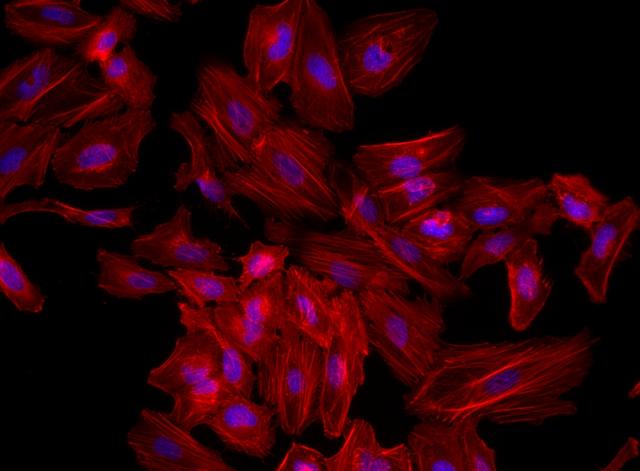Phalloidin-iFluor® 555 Conjugate
Ordering information
| Price | |
| Catalog Number | |
| Unit Size | |
| Quantity |
Additional ordering information
| Telephone | 1-800-990-8053 |
| Fax | 1-800-609-2943 |
| sales@aatbio.com | |
| International | See distributors |
| Bulk request | Inquire |
| Custom size | Inquire |
| Shipping | Standard overnight for United States, inquire for international |
Physical properties
| Molecular weight | ~1300 |
| Solvent | DMSO |
Spectral properties
| Correction Factor (260 nm) | 0.23 |
| Correction Factor (280 nm) | 0.14 |
| Extinction coefficient (cm -1 M -1) | 1000001 |
| Excitation (nm) | 557 |
| Emission (nm) | 570 |
| Quantum yield | 0.641 |
Storage, safety and handling
| Certificate of Origin | Download PDF |
| H-phrase | H301, H311, H331 |
| Hazard symbol | T |
| Intended use | Research Use Only (RUO) |
| R-phrase | R23, R24, R25 |
| Storage | Freeze (< -15 °C); Minimize light exposure |
| UNSPSC | 12352200 |
| Overview |
Molecular weight ~1300 | Correction Factor (260 nm) 0.23 | Correction Factor (280 nm) 0.14 | Extinction coefficient (cm -1 M -1) 1000001 | Excitation (nm) 557 | Emission (nm) 570 | Quantum yield 0.641 |
This orange fluorescent phalloidin conjugate (equivalent to Alexa Fluor® 555-labeled phalloidin) selectively binds to F-actins. Used at nanomolar concentrations, phalloidin derivatives are convenient probes for labeling, identifying and quantitating F-actins in formaldehyde-fixed and permeabilized tissue sections, cell cultures or cell-free experiments. Phalloidin binds to actin filaments much more tightly than to actin monomers, leading to a decrease in the rate constant for the dissociation of actin subunits from filament ends, essentially stabilizing actin filaments through the prevention of filament depolymerization. Moreover, phalloidin is found to inhibit the ATP hydrolysis activity of F-actin. Phalloidin functions differently at various concentrations in cells. When introduced into the cytoplasm at low concentrations, phalloidin recruits the less polymerized forms of cytoplasmic actin as well as filamin into stable "islands" of aggregated actin polymers, yet it does not interfere with stress fibers, i.e. thick bundles of microfilaments. The property of phalloidin is a useful tool for investigating the distribution of F-actin in cells by labeling phalloidin with fluorescent analogs and using them to stain actin filaments for light microscopy. Fluorescent derivatives of phalloidin have turned out to be enormously useful in localizing actin filaments in living or fixed cells as well as for visualizing individual actin filaments in vitro. Fluorescent phalloidin derivatives have been used as an important tool in the study of actin networks at high resolution. AAT Bioquest offers a variety of fluorescent phalloidin derivatives with different colors for multicolor imaging applications.
Example protocol
AT A GLANCE
Protocol Summary
- Prepare samples in microplate wells
- Remove liquid from samples in the plate
- Add Phalloidin-iFluor™ 555 Conjugate solution (100 μL/well)
- Stain the cells at room temperature for 20 to 90 minutes
- Wash the cells
- Examine the specimen under microscope with TRITC filter
Storage and Handling Conditions
The solution should be stable for at least 6 months if store at -20 °C. Protect the fluorescent conjugates from light, and avoid freeze/thaw cycles.Note Phalloidin is toxic, although the amount of toxin present in a vial could be lethal only to a mosquito (LD50 of phalloidin = 2 mg/kg), it should be handled with care.
PREPARATION OF WORKING SOLUTION
Phalloidin-iFluor™ 555 Conjugate working solution
Add 1 µL of Phalloidin-iFluor™ 555 Conjugate solution to 1 mL of PBS with 1% BSA.Note The stock solution of phalloidin conjugate should be aliquoted and stored at -20 °C. protected from light.
Note Different cell types might be stained differently. The concentration of phalloidin conjugate working solution should be prepared accordingly.
SAMPLE EXPERIMENTAL PROTOCOL
Stain the cells
- Perform formaldehyde fixation. Incubate cells with 3.0–4.0 % formaldehyde in PBS at room temperature for 10–30 minutes.
Note Avoid any methanol containing fixatives since methanol can disrupt actin during the fixation process. The preferred fixative is methanol-free formaldehyde. - Rinse the fixed cells 2–3 times in PBS.
- Optional: Add 0.1% Triton X-100 in PBS into fixed cells for 3 to 5 minutes to increase permeability. Rinse the cells 2–3 times in PBS.
- Add 100 μL/well (96-well plate) of Phalloidin-iFluor™ 555 Conjugate working solution into the fixed cells, and stain the cells at room temperature for 20 to 90 minutes.
- Rinse cells gently with PBS 2 to 3 times to remove excess phalloidin conjugate before plating, sealing and imaging under microscope with TRITC filter set.
Spectrum
Open in Advanced Spectrum Viewer
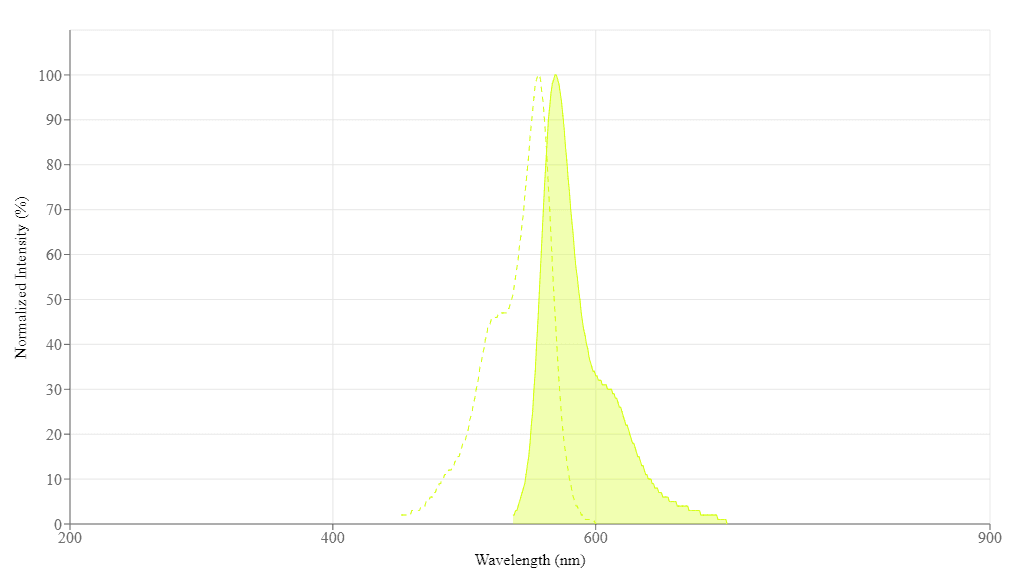

Spectral properties
| Correction Factor (260 nm) | 0.23 |
| Correction Factor (280 nm) | 0.14 |
| Extinction coefficient (cm -1 M -1) | 1000001 |
| Excitation (nm) | 557 |
| Emission (nm) | 570 |
| Quantum yield | 0.641 |
Product Family
| Name | Excitation (nm) | Emission (nm) | Extinction coefficient (cm -1 M -1) | Quantum yield | Correction Factor (260 nm) | Correction Factor (280 nm) |
| Phalloidin-iFluor® 350 Conjugate | 345 | 450 | 200001 | 0.951 | 0.83 | 0.23 |
| Phalloidin-iFluor® 405 Conjugate | 403 | 427 | 370001 | 0.911 | 0.48 | 0.77 |
| Phalloidin-iFluor® 488 Conjugate | 491 | 516 | 750001 | 0.91 | 0.21 | 0.11 |
| Phalloidin-iFluor® 514 Conjugate | 511 | 527 | 750001 | 0.831 | 0.265 | 0.116 |
| Phalloidin-iFluor® 532 Conjugate | 537 | 560 | 900001 | 0.681 | 0.26 | 0.16 |
| Phalloidin-iFluor® 594 Conjugate | 587 | 603 | 2000001 | 0.531 | 0.05 | 0.04 |
| Phalloidin-iFluor® 633 Conjugate | 640 | 654 | 2500001 | 0.291 | 0.062 | 0.044 |
| Phalloidin-iFluor® 647 Conjugate | 656 | 670 | 2500001 | 0.251 | 0.03 | 0.03 |
| Phalloidin-iFluor® 680 Conjugate | 684 | 701 | 2200001 | 0.231 | 0.097 | 0.094 |
Show More (4) | ||||||
Images
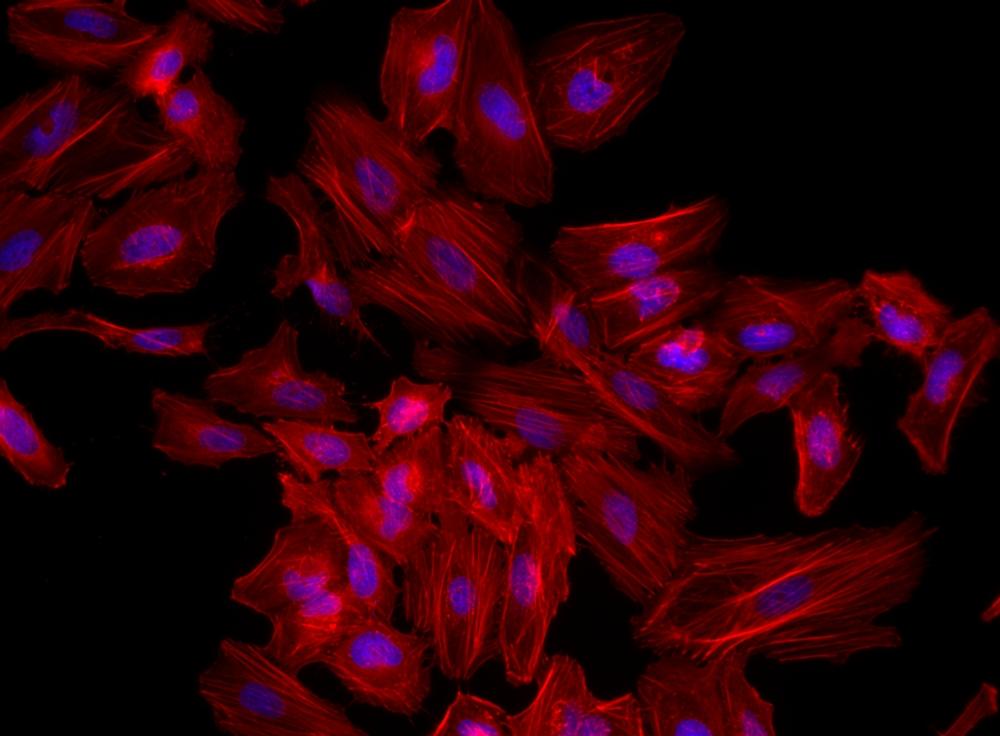
Figure 1. Fluorescence image of HeLa cells fixed with 4% formaldehyde then stained with Phalloidin-iFluor® 555 Conjugate (Cat#23119, Red) and Nuclear Blue™ DCS1 (Cat#17548, Blue), respectively.
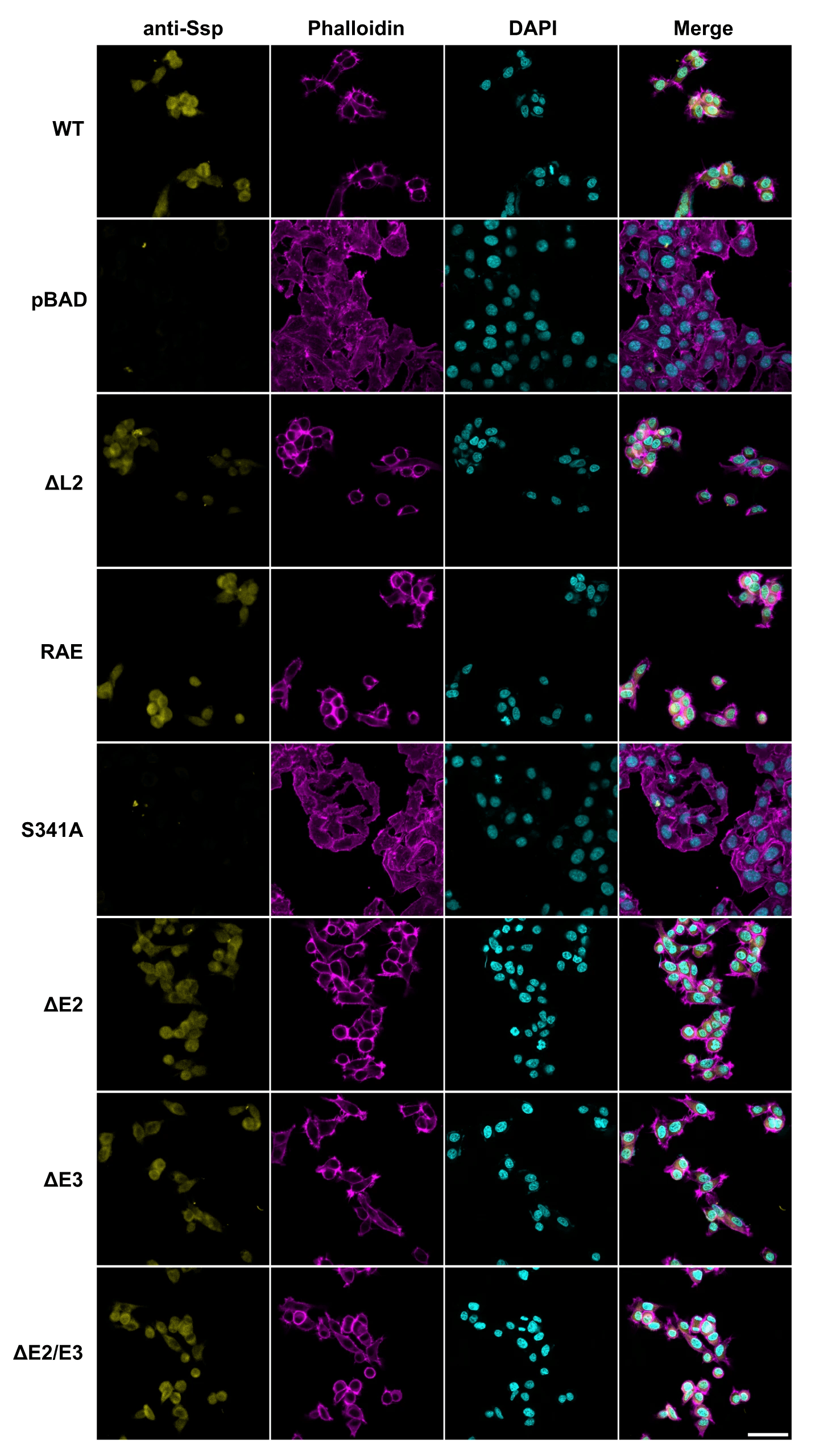
Figure 2. Confocal microscopy images of HEp-2 cells incubated with concentrated culture supernatants of Ssp variants (25 μg/mL) for 5 h. Ssp was visualised with anti-Ssp polyclonal antibody followed by Alexa Fluor Plus 647 conjugated secondary antibody (yellow), actin cytoskeleton was stained with iFluor 555 phalloidin (magenta) and nucleus stained with DAPI (cyan). Ssp variants include wildtype (WT), deletions of Loop 2 (ΔL2), deletion of active site protrusions E2 and E3 (ΔE2, ΔE3, ΔE2/ΔE3), and site-directed mutants of the active site Ser (S314A) and RGD motif (RAE). pBAD denotes vector only control. Images are representative of cells observed from at least three independent experiments. Scale bar represents 50 μm. Source: Crystal structure of a subtilisin-like autotransporter passenger domain reveals insights into its cytotoxic function. by Hor, et. al.., Nature Communications, March 2023.
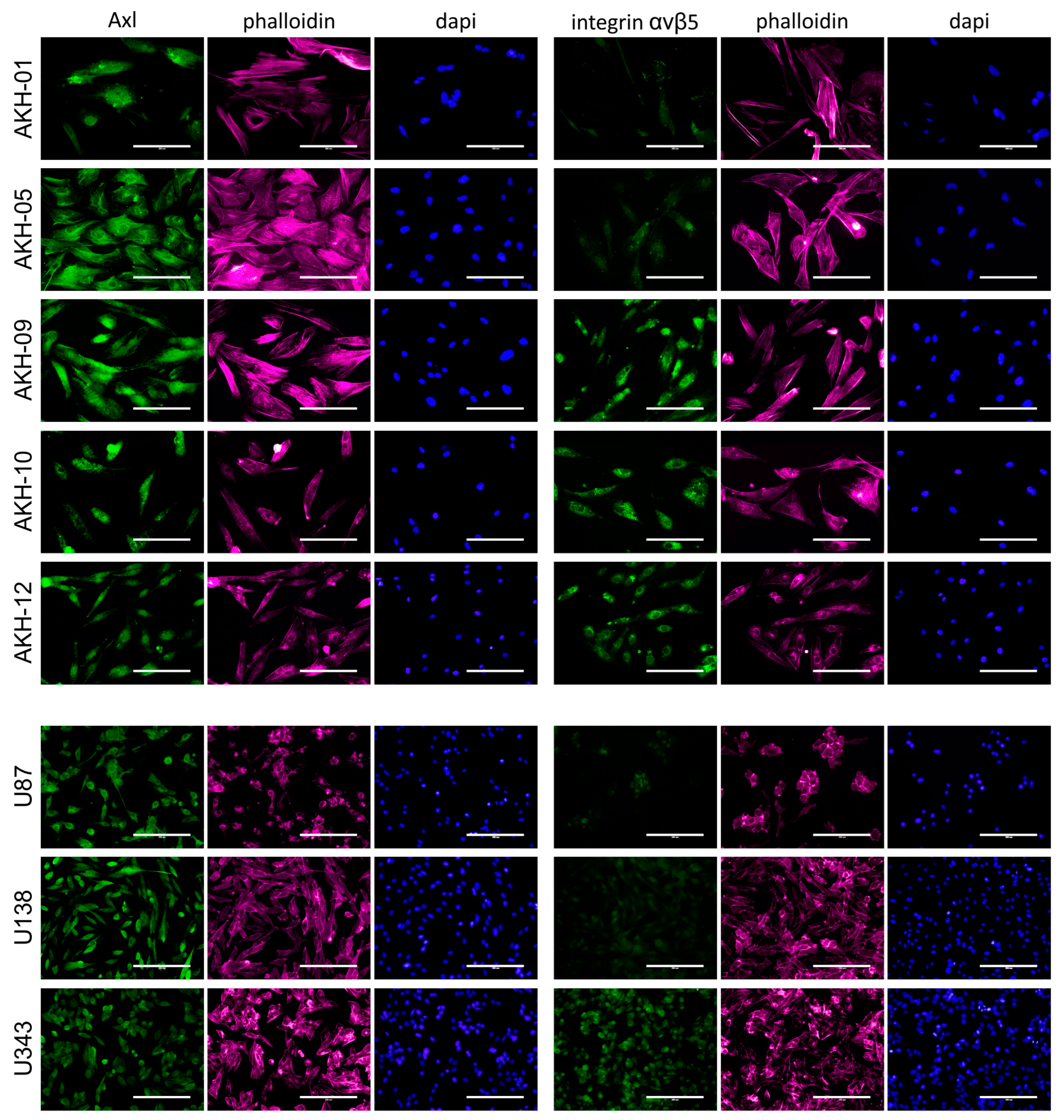
Figure 3. Axl and integrin αvβ5 expression in AKH tumor cells and glioma cell lines. Cells were cultured on glass slides, fixed with formalin, and then post-treated with Triton-X100. iFluor-555 phalloidin (red) and DAPI (blue) were used to visualize the cells and their nuclei. Bound Axl- and integrin αvβ5-specific monoclonal antibodies were detected by using a secondary anti-mouse antibody-Alexa 488 conjugate (green). Scale = 200 µm. Source: Isolation of Cells from Glioblastoma Multiforme Grade 4 Tumors for Infection with Zika Virus prME and ME Pseudotyped HIV-1 by Pöhlking et. al., Int. J. Mol. Sci. Feb. 2023.
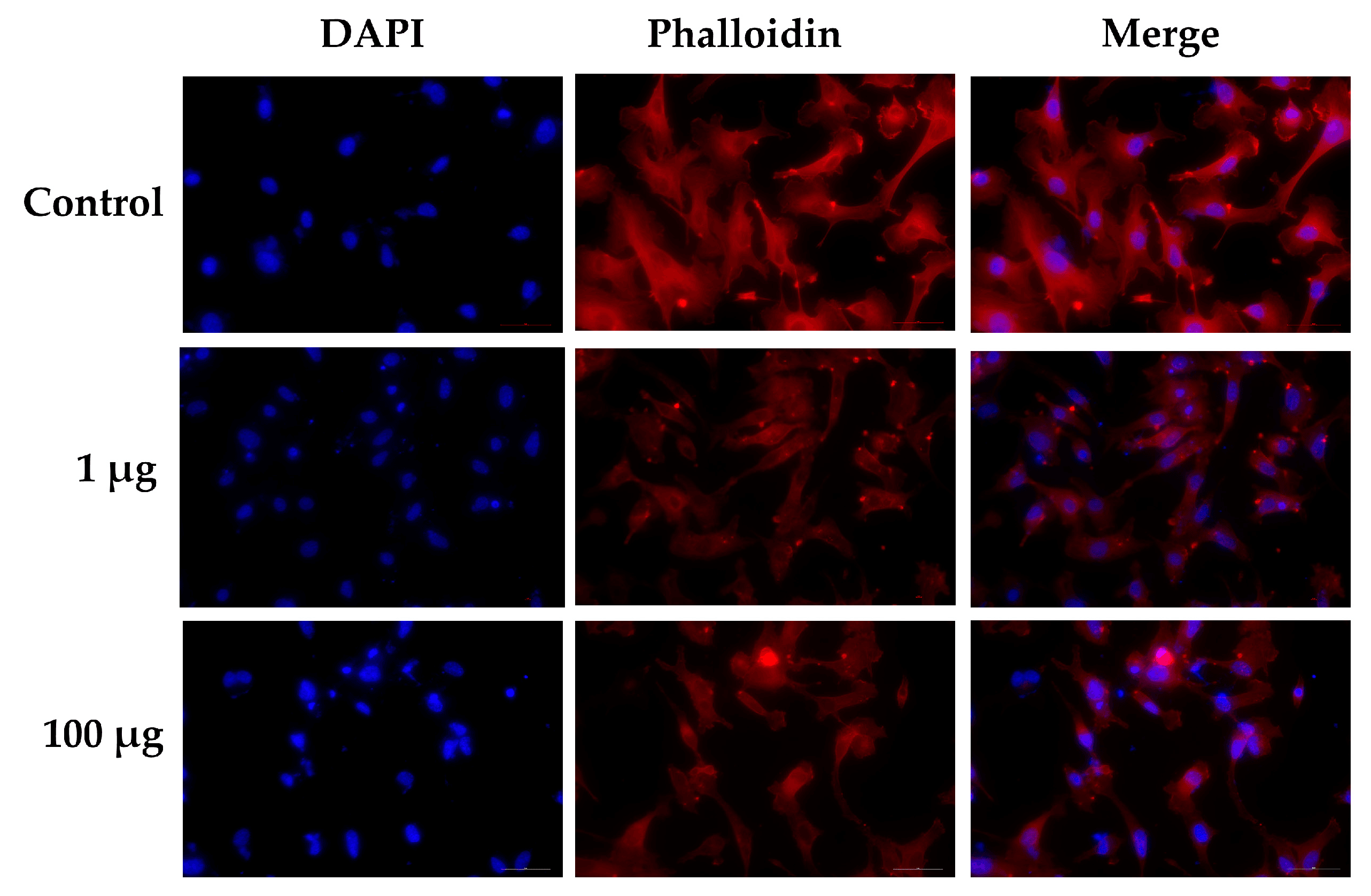
Figure 4. Effects of LPS on filamentous actin arrangement and apoptotic cell death. EA.hy926 cells were incubated with LPS as per the indicated concentrations for 48 h. The treated cell on cell culture slide chamber was stained using fluorescent-tagged phalloidin (Phalloidin-iFluor 555) to visualize the actin filament. Cell images were captured under a fluorescent microscope at 200× magnitude. Treated cells were stained using Annexin V and Dead Cell Reagent (7-AAD) and analyzed using the Muse™ Cell Analyzer. Source: Proteomic Profiling of Early Secreted Proteins in Response to Lipopolysaccharide-Induced Vascular Endothelial Cell EA.hy926 Injury by Songjang, W.; Paiyabhroma, N.; Jumroon, N.; Jiraviriyakul, A.; Nernpermpisooth, N.; Seenak, P.; Kumphune, S.; Thaisakun, S.; Phaonakrop, N.; Roytrakul, S.; et. al. Biomedicines. Nov. 2023
Citations
View all 108 citations: Citation Explorer
Transcription factor EHF interacting with coactivator AJUBA aggravates malignancy and acts as a therapeutic target for gastroesophageal adenocarcinoma
Authors: Peng, Li and Jiang, Yanyi and Chen, Hengxing and Wang, Yongqiang and Lan, Qiusheng and Chen, Shuiqin and Huang, Zhanwang and Zhang, Jingyuan and Tian, Duanqing and Qiu, Yuntan and others,
Journal: Acta Pharmaceutica Sinica B (2024)
Authors: Peng, Li and Jiang, Yanyi and Chen, Hengxing and Wang, Yongqiang and Lan, Qiusheng and Chen, Shuiqin and Huang, Zhanwang and Zhang, Jingyuan and Tian, Duanqing and Qiu, Yuntan and others,
Journal: Acta Pharmaceutica Sinica B (2024)
Comparative analysis of bile canaliculi formation in fresh and flask-delivered human hepatocytes from humanized mouse livers under sufficient oxygen supply
Authors: Tokito, Fumiya and Gong, Ya and Kurniawan, Dhimas Agung and Kaneko, Shohei and Shioda, Hiroki and Lee, Sangho and Kushima, Atsuhito and Inamatsu, Mutsumi and Tateno, Chise and Choi, Hyunjin and others,
Journal: Fundamental Toxicological Sciences (2024): 17--25
Authors: Tokito, Fumiya and Gong, Ya and Kurniawan, Dhimas Agung and Kaneko, Shohei and Shioda, Hiroki and Lee, Sangho and Kushima, Atsuhito and Inamatsu, Mutsumi and Tateno, Chise and Choi, Hyunjin and others,
Journal: Fundamental Toxicological Sciences (2024): 17--25
Engagement of $\alpha$3$\beta$1 and $\alpha$2$\beta$1 integrins by hypervirulent Streptococcus agalactiae in invasion of polarized enterocytes
Authors: De Gaetano, Giuseppe Valerio and Lentini, Germana and Coppolino, Francesco and Pietrocola, Giampiero and Beninati, Ketty
Journal: Frontiers in Microbiology (2024): 1367898
Authors: De Gaetano, Giuseppe Valerio and Lentini, Germana and Coppolino, Francesco and Pietrocola, Giampiero and Beninati, Ketty
Journal: Frontiers in Microbiology (2024): 1367898
Design and validation of a custom-made system to measure transepithelial electrical impedance in human corneas preserved in active storage machine
Authors: Mentek, Marielle and Peyret, Benjamin and Zouari, Siwar and Urbaniak, S{\'e}bastien and Papillon, Jean-Marie and Crouzet, Emmanuel and Perrache, Chantal and Hodin, Sophie and Delavenne, Xavier and He, Zhiguo and others,
Journal: International Journal of Pharmaceutics: X (2024): 100234
Authors: Mentek, Marielle and Peyret, Benjamin and Zouari, Siwar and Urbaniak, S{\'e}bastien and Papillon, Jean-Marie and Crouzet, Emmanuel and Perrache, Chantal and Hodin, Sophie and Delavenne, Xavier and He, Zhiguo and others,
Journal: International Journal of Pharmaceutics: X (2024): 100234
Curcumin encapsulated in milk small extracellular vesicles as a nanotherapeutic alternative in experimental chronic liver disease
Authors: Albaladejo-Garc{\'\i}a, Virginia and Mor{\'a}n, Laura and Santos-Coquillat, Ana and Gonz{\'a}lez, Mar{\'\i}a I and Ye, Hui and Ogando, Elena V{\'a}zquez and Vaquero, Javier and Cubero, Francisco Javier and Desco, Manuel and Salinas, Beatriz
Journal: Biomedicine \& Pharmacotherapy (2024): 116381
Authors: Albaladejo-Garc{\'\i}a, Virginia and Mor{\'a}n, Laura and Santos-Coquillat, Ana and Gonz{\'a}lez, Mar{\'\i}a I and Ye, Hui and Ogando, Elena V{\'a}zquez and Vaquero, Javier and Cubero, Francisco Javier and Desco, Manuel and Salinas, Beatriz
Journal: Biomedicine \& Pharmacotherapy (2024): 116381
Cardiac endothelial ischemia/reperfusion injury-derived protein damage-associated molecular patterns disrupt the integrity of the endothelial barrier
Authors: Kumphune, Sarawut and Seenak, Porrnthanate and Paiyabhrom, Nitchawat and Songjang, Worawat and Pankhong, Panyupa and Jumroon, Noppadon and Thaisakun, Siriwan and Phaonakrop, Narumon and Roytrakul, Sittiruk and Malakul, Wachirawadee and others,
Journal: Heliyon (2024)
Authors: Kumphune, Sarawut and Seenak, Porrnthanate and Paiyabhrom, Nitchawat and Songjang, Worawat and Pankhong, Panyupa and Jumroon, Noppadon and Thaisakun, Siriwan and Phaonakrop, Narumon and Roytrakul, Sittiruk and Malakul, Wachirawadee and others,
Journal: Heliyon (2024)
Engineering Anisotropic Cell Models: Development of Collagen Hydrogel Scaffolds with Magneto-Responsive PEG Microgels for Tissue Engineering Applications
Authors: Castro, Ana L and Vedaraman, Sitara and Haraszti, Tam{\'a}s and Barbosa, M{\'a}rio A and Gon{\c{c}}alves, Raquel M and De Laporte, Laura
Journal: Advanced Materials Technologies (2024): 2301391
Authors: Castro, Ana L and Vedaraman, Sitara and Haraszti, Tam{\'a}s and Barbosa, M{\'a}rio A and Gon{\c{c}}alves, Raquel M and De Laporte, Laura
Journal: Advanced Materials Technologies (2024): 2301391
Nuclear transport of phosphorylated LanCL2 promotes invadopodia formation and tumor progression of glioblastoma by activating STAT3/Cortactin signaling
Authors: Zhao, Hua-fu and Liu, Yun-sheng and Wang, Jing and Wu, Chang-peng and Zhou, Xiu-ming and Cai, Lin-rong and Liu, Jing and Liu, Xiao-jia and Xu, Yan-wen and Li, Wei-ping and others,
Journal: Journal of Advanced Research (2024)
Authors: Zhao, Hua-fu and Liu, Yun-sheng and Wang, Jing and Wu, Chang-peng and Zhou, Xiu-ming and Cai, Lin-rong and Liu, Jing and Liu, Xiao-jia and Xu, Yan-wen and Li, Wei-ping and others,
Journal: Journal of Advanced Research (2024)
Transduction Efficiency of Zika Virus E Protein Pseudotyped HIV-1 gfp and Its Oncolytic Activity Tested in Primary Glioblastoma Cell Cultures
Authors: Formanski, Jan Patrick and Ngo, Hai Dang and Grunwald, Vivien and P{\"o}hlking, Celine and Jonas, Jana Sue and Wohlers, Dominik and Schwalbe, Birco and Schreiber, Michael
Journal: Cancers (2024): 814
Authors: Formanski, Jan Patrick and Ngo, Hai Dang and Grunwald, Vivien and P{\"o}hlking, Celine and Jonas, Jana Sue and Wohlers, Dominik and Schwalbe, Birco and Schreiber, Michael
Journal: Cancers (2024): 814
Extracellular Matrix Mimicking Dynamic Interpenetrating Network Hydrogel for Skin Tissue Engineering
Authors: Wang, Weibin and Dai, Jiajia and Huang, Yvfeng and Li, Xiaomeng and Yang, Jianmin and Zheng, Yunquan and Shi, Xianai
Journal: Chemical Engineering Journal (2023): 141362
Authors: Wang, Weibin and Dai, Jiajia and Huang, Yvfeng and Li, Xiaomeng and Yang, Jianmin and Zheng, Yunquan and Shi, Xianai
Journal: Chemical Engineering Journal (2023): 141362
References
View all 127 references: Citation Explorer
Improved penile histology by phalloidin stain: circular and longitudinal cavernous smooth muscles, dual-endothelium arteries, and erectile dysfunction-associated changes
Authors: Lin G, Qiu X, F and el TM, Albersen M, Wang Z, Lue TF, Lin CS.
Journal: Urology (2011): 970 e1
Authors: Lin G, Qiu X, F and el TM, Albersen M, Wang Z, Lue TF, Lin CS.
Journal: Urology (2011): 970 e1
Phalloidin perturbs the interaction of human non-muscle myosin isoforms 2A and 2C1 with F-actin
Authors: Diensthuber RP, Muller M, Heissler SM, Taft MH, Chizhov I, Manstein DJ.
Journal: FEBS Lett (2011): 767
Authors: Diensthuber RP, Muller M, Heissler SM, Taft MH, Chizhov I, Manstein DJ.
Journal: FEBS Lett (2011): 767
pH-(low)-insertion-peptide (pHLIP) translocation of membrane impermeable phalloidin toxin inhibits cancer cell proliferation
Authors: An M, Wijesinghe D, Andreev OA, Reshetnyak YK, Engelman DM.
Journal: Proc Natl Acad Sci U S A (2010): 20246
Authors: An M, Wijesinghe D, Andreev OA, Reshetnyak YK, Engelman DM.
Journal: Proc Natl Acad Sci U S A (2010): 20246
Labeling cytoskeletal F-actin with rhodamine phalloidin or fluorescein phalloidin for imaging
Authors: Chazotte B., undefined
Journal: Cold Spring Harb Protoc (2010): pdb prot4947
Authors: Chazotte B., undefined
Journal: Cold Spring Harb Protoc (2010): pdb prot4947
Protective effect of bile acid derivatives in phalloidin-induced rat liver toxicity
Authors: Herraez E, Macias RI, Vazquez-Tato J, Hierro C, Monte MJ, Marin JJ.
Journal: Toxicol Appl Pharmacol (2009): 21
Authors: Herraez E, Macias RI, Vazquez-Tato J, Hierro C, Monte MJ, Marin JJ.
Journal: Toxicol Appl Pharmacol (2009): 21
Effect of Phalloidin on Filaments Polymerized from Heart Muscle Adp-Actin Monomers
Authors: Vig A, Dudas R, Kupi T, Orban J, Hild G, Lorinczy D, Nyitrai M.
Journal: J Therm Anal Calorim (2009): 721
Authors: Vig A, Dudas R, Kupi T, Orban J, Hild G, Lorinczy D, Nyitrai M.
Journal: J Therm Anal Calorim (2009): 721
In vitro inhibition of OATP-mediated uptake of phalloidin using bile acid derivatives
Authors: Herraez E, Macias RI, Vazquez-Tato J, Vicens M, Monte MJ, Marin JJ.
Journal: Toxicol Appl Pharmacol (2009): 13
Authors: Herraez E, Macias RI, Vazquez-Tato J, Vicens M, Monte MJ, Marin JJ.
Journal: Toxicol Appl Pharmacol (2009): 13
Processing of the phalloidin proprotein by prolyl oligopeptidase from the mushroom Conocybe albipes
Authors: Luo H, Hallen-Adams HE, Walton JD.
Journal: J Biol Chem (2009): 18070
Authors: Luo H, Hallen-Adams HE, Walton JD.
Journal: J Biol Chem (2009): 18070
Pygmy squids and giant brains: mapping the complex cephalopod CNS by phalloidin staining of vibratome sections and whole-mount preparations
Authors: Wollesen T, Loesel R, Wanninger A.
Journal: J Neurosci Methods (2009): 63
Authors: Wollesen T, Loesel R, Wanninger A.
Journal: J Neurosci Methods (2009): 63
Anti-acetylated tubulin antibody staining and phalloidin staining in the starlet sea anemone Nematostella vectensis
Authors: Genikhovich G, Technau U.
Journal: Cold Spring Harb Protoc (2009): pdb prot5283
Authors: Genikhovich G, Technau U.
Journal: Cold Spring Harb Protoc (2009): pdb prot5283
Application notes
A New Protein Crosslinking Method for Labeling and Modifying Antibodies
A Novel Fluorescent Probe for Imaging and Detecting Hydroxyl Radical in Living Cells
A Novel NO Wash Probeniceid-Free Calcium Assay for Functional Analysis of GPCR and Calcium Channel Targets
Biotin Labeling Molecules and Their Biological Applications
Buccutite™ Bioconjugation Technology
A Novel Fluorescent Probe for Imaging and Detecting Hydroxyl Radical in Living Cells
A Novel NO Wash Probeniceid-Free Calcium Assay for Functional Analysis of GPCR and Calcium Channel Targets
Biotin Labeling Molecules and Their Biological Applications
Buccutite™ Bioconjugation Technology
FAQ
How can I lyse my cells without lysing the nuclear membrane?
What are the differences between calcium ion indicators: Cal 520, Cal 520FF, and Cal 520N?
How do I make an AM ester stock solution?
Can we fix cells with glutaraldehyde and then stain with fluorescent phalloidin?
What is the difference between FluoroQuest Anti-fading Kit I and FluoroQuest Anti-fading Kit II?
What are the differences between calcium ion indicators: Cal 520, Cal 520FF, and Cal 520N?
How do I make an AM ester stock solution?
Can we fix cells with glutaraldehyde and then stain with fluorescent phalloidin?
What is the difference between FluoroQuest Anti-fading Kit I and FluoroQuest Anti-fading Kit II?
